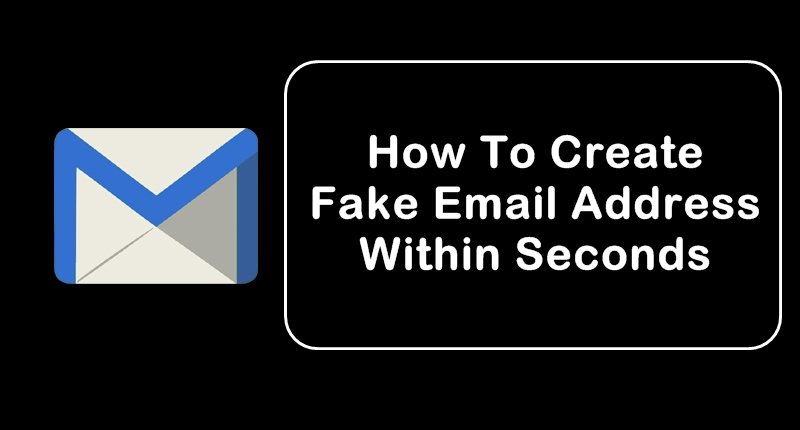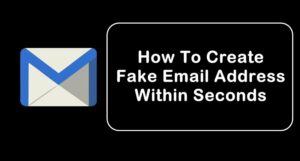
In today’s digital world, an email address is required for a variety of online activities. However, there may be times when a temporary or pseudonymous email account is required for privacy or security reasons. This post will show you how to construct a bogus email address and password while keeping ethical considerations and internet safety in mind.

What are Fake Email Addresses?
Fake email addresses are email accounts made for temporary or specific purposes. They are also known as disposable, transient, or pseudonymous email addresses. These addresses can be used to safeguard your identity, maintain your privacy, avoid spam, or gain access to content that requires email registration without disclosing your personal information.
The Benefits of Using Fake Email Addresses
There are several legitimate reasons to use a phony email address:
- Protection of your privacy: By utilizing a temporary email account, you can avoid unwanted solicitations, marketing communications, or potential data breaches.
- Spam Avoidance: Disposable email addresses can assist you in avoiding spam emails and unwanted subscriptions.
- Online Registrations: Email registrations are required for some online platforms or services, but you may be cautious to reveal your email address. In such instances, a bogus email account can be employed.
- Testing & Trials: Using a false email address when signing up for trials or testing services might prevent unwanted follow-ups after the trial time has ended.
Risks and Ethical Considerations
While creating a bogus email address and password can be useful, it is critical to consider the hazards and ethical factors listed below:
- Misuse and Illegal Activities: Creating phony email accounts for malevolent intentions or indulging in illicit activities is unethical and may result in legal ramifications.
- Fraud and impersonation: Using fictitious email addresses to deceive or defraud people is not just immoral, but also unlawful.
- Terms of Service Violation: Some online sites forbid the use of disposable or pseudonymous email addresses. Violations of these terms may result in the suspension or cancellation of your account.
How to Create a Fake Email Address
Use Temporary Email Services
Temporary email providers give disposable email accounts that are valid for a limited time, usually a few minutes to a few hours. Guerrilla Mail, Temp Mail, and Mailinator are some prominent temporary email providers.
Generate Disposable Email Addresses
Some email service providers allow you to create temporary email accounts within your primary account. This enables you to create distinct email identities for various purposes while still retaining access to your primary account. The “+” addressing feature in Gmail is one example of this.
Make use of Email Forwarding Services
You can use email forwarding services to set up email aliases that forward messages to your primary email address. This allows you to receive emails without revealing your true email address. Email forwarding services include SimpleLogin and AnonAddy.
Consider Using Pseudonymous Email Accounts
If you need a more permanent pseudonymous email address, consider setting up a new email account with a pseudonym or another identity. This can provide some privacy while still allowing long-term access to your emails.
List of 5 platforms for creating fake emails
Here are five platforms where you can create phony email addresses:
- SimpleLogin: SimpleLogin is an email forwarding service that allows you to create an infinite number of email aliases. It allows you to forward emails to your primary email account while protecting your personal information.
- AnonAddy: Another email forwarding service that allows you to establish aliases and route incoming emails to your primary email address is AnonAddy. It has functions like custom domain support and email alias management.
- Guerrilla Mail: Guerrilla Mail provides throwaway email addresses that are only valid for a limited time. It enables you to receive and send emails without requiring registration or personal information.
- Temp Mail: Temp Mail gives temporary email addresses that are only valid for a short period of time. It supports email and attachments, making it ideal for rapid and temporary communication.
- Mailinator: Mailinator is a website that provides free, public, and disposable email addresses. Mailinator allows you to create an email account on the fly and receive emails without requiring a sign-up or password.
Please keep in mind that, while these platforms provide temporary or pseudonymous email solutions, it is critical to utilize them responsibly and in accordance with the terms of service of the platforms with which you engage.
Creating a Password for a Fake Email Address
Choose a Strong and Unique Password
When generating a password for a bogus email account, make it strong and one-of-a-kind. Include uppercase and lowercase letters, numbers, and special characters in your message. Avoid using information that is easily guessed, such as your name, birthdate, or common words.
Utilize Password Managers
Consider utilizing a password manager such as LastPass, Dashlane, or 1Password to securely manage numerous passwords. These programs generate strong passwords, store them securely, and autofill them when needed.
Turn on Two-Factor Authentication (2FA)
Enable two-factor authentication (2FA) if your email service provider enables it to improve the security of your bogus email account. 2FA adds an additional degree of security by requiring a secondary verification step, usually by a code given to your mobile device.
Keeping It Safe and Ethical
- Avoid Engaging in Illegal Activities: Create bogus email addresses only for genuine and ethical causes. Illegal acts with bogus email addresses are strictly forbidden.
- Observe the Terms of Service: Understand the terms of service for the sites you utilize. Disposable or pseudonymous email accounts are not permitted on several services. To avoid account suspension or cancellation, abide by these terms.
- Use Responsibly: Ensure that your actions with fake email addresses do not harm others or violate their privacy. Be mindful of the information you share and the actions you take online.
Conclusion
Creating a fake email address and password can be a useful tool for protecting your privacy and avoiding spam. By following the outlined methods, you can generate temporary or pseudonymous email addresses while considering ethical considerations. Remember to use fake email addresses responsibly and adhere to legal and ethical standards in your online activities.
Frequently Ask Questions
Is it legal to create a fake email address?
Creating a fake email address is generally legal as long as it is used for legitimate purposes and does not involve illegal activities or fraudulent intent.
Can I use a bogus email address to register for things online?
Yes, you can use a bogus email address to register for internet services. Be warned, however, that some platforms may require verification or may refuse temporary email addresses.
How long am I allowed to use a temporary email address?
The duration of a temporary email account is determined by the provider used. Some temporary email addresses are only valid for a few minutes, while others may be valid for several hours.
Are forged email addresses entirely anonymous?
While fake email addresses can provide some anonymity, keep in mind that other identifying information or behaviors can still be traced.
Can I use a false email address to send and receive emails?
Yes, you can send and receive emails with a fake email address as long as the chosen method allows for email functionality.





Leave a Reply